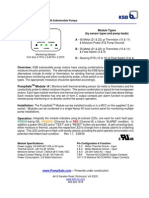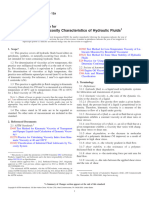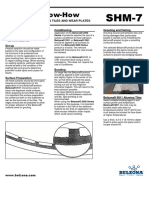Guía de Interpretación de Análisis de Refrigerante
Guía de Interpretación de Análisis de Refrigerante
Uploaded by
Teófilo LimasCopyright:
Available Formats
Guía de Interpretación de Análisis de Refrigerante
Guía de Interpretación de Análisis de Refrigerante
Uploaded by
Teófilo LimasOriginal Title
Copyright
Available Formats
Share this document
Did you find this document useful?
Is this content inappropriate?
Copyright:
Available Formats
Guía de Interpretación de Análisis de Refrigerante
Guía de Interpretación de Análisis de Refrigerante
Uploaded by
Teófilo LimasCopyright:
Available Formats
The Science Behind Equipment Reliability
Coolant Analysis
BASIC ANALYSIS
Test
Glycol%
Physical Tests Typical Values or Flagging Limits Function or Effect
Glycol level will vary depending on glycol type, application, and the pressure, elevation, and temperature at which the system operates. In general, freeze point should be a minimum 5C lower than the expected ambient temperature. In general, boiling point should be a minimum 10C above the maximum operating temperature of the cooling system. Glycol is used to suppress the freeze point and elevate the boiling point of coolant. Serious damage to the engine and radiator can occur when water expands when frozen. Boiling will dramatically reduce the heat transfer properties of coolant. Boiling point decreases 1.7C for every 1000 feet above sea level, and increases approximately 1.5C for each system psig. Indication of the acidity/alkalinity of the coolant. Improper pH levels can lead to metal corrosion. Low pH can indicate combustion blow by, local hot spot or air leak. High pH may be a sign of excessive additive treatment or a blend of conventional and long life coolants. (S/cm) Measure of the coolants ability to resist carrying electrical charge. High conductivity can reduce to e ectiveness of inhibitors and lead to cooling system corrosion.
Freeze Point Boiling Point
pH
Conventional Coolant: Between 8.5 and 11 Long Life Coolant: Between 7 and 9
Conductivity
> 6600 Reportable > 7500 Unacceptable > 8000 Severe
Ion Chromatography
Note: Due to interferences inherent to some coolant formulations and chemistry, some ions may not be reportable. Nitrites > 1200 ppm (nitrite only formulation) Primary inhibitor for iron protection; used to prevent > 300 ppm (Nitrite and Molybdate formulation) cavitation of wet sleeve liners. Rapid depletion of Nitrite and an increase in glycolate indicates general overheating of the coolant system or a localized hot spot. Rapid depletion of Nitrite without increase in Glycolates indicates Nitrite oxidation by a positive stray current. Molybdates > 300 ppm (Nitrite and Molybdate formulation) Primary inhibitor for iron protection; used to prevent Alarms are based on New Coolant Reference cavitation of wet sleeve liners. Nitrates Reportable +/- 10% from new coolant Unacceptable +/- 20% from new coolant Severe +/- 30% from new coolant New Coolant < 25 ppm Used Coolant < 75 ppm Protection of light alloys, solder and aluminum from corrosion. Nitrate levels may increase as nitrites are chemically transformed into Nitrate. Contaminant that can lead to extreme corrosion. Chlorides can result from aging coolant, or come from hydrochloric acid cleaners or chlorinated water. Distilled water is recommended when diluting concentrated (not pre-mixed) glycol. Iron corrosion protection and pH control. Over treatment can lead to heavy precipitation in the coolant resulting in a plugged radiator or oil cooler. Contaminant that can combine with calcium to form scale. Sulphates can result from aging coolant, or come from sulfuric acid cleaners or tap water. Distilled water is recommended when diluting concentrated (not pre-mixed) glycol. Breakdown (oxidation) by-product of glycol usually caused by localized overheating, air leak or general excessive temperature. Promotes Iron corrosion Breakdown (oxidation) by-product of glycol usually caused by localized overheating, air leak or general excessive temperature. Promotes Copper corrosion and leads to hard deposit precipitates.
Chlorides
Phosphates
> 25% Reduction from new coolant
Sulphates
New Coolant < 50 ppm Used Coolant < 300 ppm
Glycolates
Oxalates
Typical <1000 ppm Reportable >1500 ppm Unacceptable >2000 ppm Severe >2500 ppm Typical <25 ppm Reportable >50 ppm Unacceptable >100 ppm Severe >150 ppm
www.uidlife.com
The Science Behind Equipment Reliability
Coolant Analysis Interpretation Guide
Color & Clarity
Coolant should be clear and bright. A change from n ew is indicative of a mixing of coolants and/ or contamination/ degradation. Coolant Analysis Report Abbreviations:
CCO - Clear, colorless OWH - O White RED - Red LRE - Light Red FOR - Fluorescent Orange ORA - Orange CLR - Clear
LOR - Light orange FYE - Fluorescent Yellow LGR - Light Green FGR - Fluorescent Green YGR - Yellow-Green DBL - Dark Blue HAZ - Hazy
BLU - Blue LBL - Light Blue PUR - Purple LPU - Light Purple FPI - Fluorescent Pink PIN - Pink CLD - Cloudy
DBR - Dark Brown BRO - Brown LBR - Light Brown RBR - Red Brown YBR - Yellow-Brown GBR - Green Brown
Odor
Unusual odors in coolant can be an indication of contamination such as diesel fuel, residual cleaners, or adverse conditions such as general or localized overheating. Coolant Analysis Report Abbreviations: GD - Good, acceptable FUE - Diesel fuel NH4 - Ammonia BUR - Burnt odor FUN - Fungal odor SUL - Sulphide SOL - Solvent
Precipitate / Magnetic Precipitate
Precipitates are often caused by poor source of water or over concentration of coolant inhibitors, air leaks, or defective electrical grounds. Solids in the cooling system can lead to water pump and seal abrasion and subsequent leakage liner pitting, copper and aluminum corrosion, and plugged oil cooler and radiator. Magnetic Precipitate is a sign of severe wear in cooling system. Coolant Analysis Report Abbreviations: F L U - F luffy /wooly F L A - F la k e s S L U - S ludg e (Includes Basic Coolant Analysis) C H U Chunks
ADVANCED COOLANT ANALYSIS
Test
Reserve Alkalinity
Typical Range
Alarms are based on New Coolant Reference
Function or E ect
A measure of the coolants ability to neutralize acids from glycol oxidation products or exhaust blow by. High reserve alkalinity is an indication of over concentration of additives. Low reserve alkalinity is an indication of over dilution or neutralization of additives.
Specto-chemical (ppm) Reportable
Iron Copper Lead Tin Silver Aluminum Zinc Calcium Magnesium Silicon Potassium Sodium Boron Phosphorous Molybdenum
Unacceptable
Severe
20 15 15 15 15 15 20 100 40
Primary Source
(Some elements may originate from 2 or more sources ) Wear Element Wear Element Wear Element Wear Element Wear Element Wear Element Wear Element Contaminant (typically from water) Contaminant (typically from water) Additive Element Additive Element Additive Element Additive Element Additive Element Additive Element
10 15 5 10 5 10 5 10 5 10 5 10 10 15 60 80 20 30 Alarms are based on New Coolant Reference Alarms are based on New Coolant Reference > 2000 ppm Long Life Coolants < 5000 ppm Conventional coolants Alarms are based on New Coolant Reference Alarms are based on New Coolant Reference Alarms are based on New Coolant Reference
Coolants are carefully formulated mixtures of water, glycol, and inhibitors. Mixing coolants at anytime is not recommended and may lead to a loss of protective ability, damage to cooling system and engine, and/or a reduced coolant service life. Use of distilled or deionized water is recommended when added water is needed. Change coolant as per engine manufacturers instructions. Coolant Analysis is recommended up to every 250 hours. This guide is intended as a general reference only. Alarm limits indicated are typical; actual alarm limits may di er and are dependant on application, coolant type and other factors. Adequately completed coolant sample information is important for accurate ags and recommendations.
You might also like
- Elemental Analysis of Distillate Products by Inductively Coupled Plasma Mass Spectrometry (ICP-MS)Document13 pagesElemental Analysis of Distillate Products by Inductively Coupled Plasma Mass Spectrometry (ICP-MS)Essam Eldin Metwally AhmedNo ratings yet
- Welding Alloys USA Inc. Safety Data Sheet: Section 1: Product and Company IdentificationDocument9 pagesWelding Alloys USA Inc. Safety Data Sheet: Section 1: Product and Company IdentificationUmar YaqoobNo ratings yet
- Sanas TR 45-03Document8 pagesSanas TR 45-03joko purwanto100% (2)
- Astm D3306Document5 pagesAstm D3306mfelwazieryNo ratings yet
- MSDS - KI25X Transformer OilDocument5 pagesMSDS - KI25X Transformer OilBrion Bara Indonesia100% (1)
- IP 346 (Report by Institute of Petroleum)Document24 pagesIP 346 (Report by Institute of Petroleum)Hida Al-FithriNo ratings yet
- El Analisis de Aceite Como Una Buena Practica de ManteniDocument49 pagesEl Analisis de Aceite Como Una Buena Practica de ManteniCarlos Alberto Martínez Escobar100% (1)
- Shell Rimula R3 40Document2 pagesShell Rimula R3 40francisNo ratings yet
- Komatsu Coolant High Performance Long Life Coolant With Low Impact On Global EnvironmentDocument7 pagesKomatsu Coolant High Performance Long Life Coolant With Low Impact On Global EnvironmentDian Wahyu AlfatahNo ratings yet
- Pumpsafe General InformationDocument6 pagesPumpsafe General InformationJonathan Arturo Zapata Reyes100% (1)
- PVC Wiring Degradation PDFDocument19 pagesPVC Wiring Degradation PDFKaarthicNatarajanNo ratings yet
- How Industrial Businesses Can Reduce Production Costs With Reverse Osmosis: Industrial Reverse OsmosisFrom EverandHow Industrial Businesses Can Reduce Production Costs With Reverse Osmosis: Industrial Reverse OsmosisRating: 5 out of 5 stars5/5 (1)
- CSTR Lab ReportDocument10 pagesCSTR Lab ReportErraFatihaNo ratings yet
- Ionol CP: Specification Property Value Unit MethodDocument5 pagesIonol CP: Specification Property Value Unit MethodFrancisco PerezNo ratings yet
- CANNON Manual Viscosity Testing Brochure PDFDocument16 pagesCANNON Manual Viscosity Testing Brochure PDFAnonymous E6y94B7ncBNo ratings yet
- What Is RULER: Oil Analysis For Predictive MaintenanceDocument2 pagesWhat Is RULER: Oil Analysis For Predictive Maintenancemohamed abdelmoniemNo ratings yet
- Transformer OilDocument2 pagesTransformer OilAdetunji TaiwoNo ratings yet
- 3D Trasar Light Cooling Water System: DescriptionDocument6 pages3D Trasar Light Cooling Water System: DescriptionIsmail YudhistiraNo ratings yet
- Sop Wear Debris Analysis (Astm D-7690)Document2 pagesSop Wear Debris Analysis (Astm D-7690)tribo technicalNo ratings yet
- Oil Shell TransformersDocument3 pagesOil Shell TransformersAllan MastinoNo ratings yet
- Low-Temperature Viscosity of Automotive Fluid Lubricants Measured by Brookfield ViscometerDocument9 pagesLow-Temperature Viscosity of Automotive Fluid Lubricants Measured by Brookfield ViscometerPhạm Hoàng Ái Lệ100% (1)
- Tech Trol Gold Synthetic LubricantDocument2 pagesTech Trol Gold Synthetic LubricantAzhar1109No ratings yet
- Corr Shield NT 4292Document9 pagesCorr Shield NT 4292Donatas BertasiusNo ratings yet
- D 2983 - 04 Low ViscozityDocument13 pagesD 2983 - 04 Low ViscozityCorina StanculescuNo ratings yet
- Calculation of Winding Temperatures in DistributionDocument6 pagesCalculation of Winding Temperatures in DistributionKhashane Willy Mohale100% (1)
- Motor OfflineDocument10 pagesMotor OfflineSIRAJ BNo ratings yet
- Astm D 2285 Tension Interfacial Por El Metodo de La Gota de AguaDocument3 pagesAstm D 2285 Tension Interfacial Por El Metodo de La Gota de AguaJose Maria Castillo HernandezNo ratings yet
- Astm D1122-22Document3 pagesAstm D1122-22solalehNo ratings yet
- Astm 2017-D7344 PDFDocument20 pagesAstm 2017-D7344 PDFsunaryo putra jayaNo ratings yet
- Transformer OilsDocument2 pagesTransformer OilsAbegail BernabeNo ratings yet
- Nas Cleanlines OilDocument1 pageNas Cleanlines OilAnonymous miBU7ERNo ratings yet
- Uop 481 - 10Document13 pagesUop 481 - 10lovehackinggalsNo ratings yet
- NACE 0374 Laboratory Test Procedure To Screening Scale InhibitorDocument204 pagesNACE 0374 Laboratory Test Procedure To Screening Scale InhibitorrajikhannaNo ratings yet
- ASTM Water-StandardList - 2009Document5 pagesASTM Water-StandardList - 2009MiguelNo ratings yet
- TT Developing Turbine OilsDocument2 pagesTT Developing Turbine Oilssatya_chagantiNo ratings yet
- Dissolved Gas Analysis Serminal Tutorial Solution 27 June 2013Document15 pagesDissolved Gas Analysis Serminal Tutorial Solution 27 June 2013သူ ရိန်No ratings yet
- EdtaDocument8 pagesEdtabalajikundetiNo ratings yet
- Defining The Viscosity Characteristics of Hydraulic Fluids: Standard Practice ForDocument6 pagesDefining The Viscosity Characteristics of Hydraulic Fluids: Standard Practice ForTarlan AllahverdiyevNo ratings yet
- Vaccum DehydratorDocument4 pagesVaccum DehydratorSimbu ArasanNo ratings yet
- F F o P L: Aquapoxy - 3800Document3 pagesF F o P L: Aquapoxy - 3800Karishma PrabhuNo ratings yet
- Transformer Oil Processing and Preliminary Electrical Testing 083022Document74 pagesTransformer Oil Processing and Preliminary Electrical Testing 083022Robert Sproule100% (1)
- Pulverizer and Fuel Delivery GuidelinesDocument152 pagesPulverizer and Fuel Delivery GuidelinesnaseemNo ratings yet
- Oil, Engine, Diesel, Service Fill WSS-M2C171-F1 1. Scope: Engineering Material SpecificationDocument12 pagesOil, Engine, Diesel, Service Fill WSS-M2C171-F1 1. Scope: Engineering Material SpecificationJesús PalomaresNo ratings yet
- SOP For ASTM D 4052Document1 pageSOP For ASTM D 4052farhan2ansariNo ratings yet
- Astm D7414 22Document4 pagesAstm D7414 22barcaza_13No ratings yet
- ASTM D95-05 (Metodo de Prueba Estandar para Agua en Productos Del Petroleo y Materiales Bituminosos Por Destilación) PDFDocument6 pagesASTM D95-05 (Metodo de Prueba Estandar para Agua en Productos Del Petroleo y Materiales Bituminosos Por Destilación) PDFDaniel FelipeNo ratings yet
- Determination of Metals in Lubricating Greases by Inductively Coupled Plasma Atomic Emission SpectrometryDocument7 pagesDetermination of Metals in Lubricating Greases by Inductively Coupled Plasma Atomic Emission SpectrometryThang DoNo ratings yet
- ASTM G 50 - 76 r97 - Rzuwltc2ujk3rteDocument5 pagesASTM G 50 - 76 r97 - Rzuwltc2ujk3rteSamuel EduardoNo ratings yet
- CON 700 ManualDocument24 pagesCON 700 ManualVijay YadavNo ratings yet
- Hardness, Calcium: Titration Method With Edta Method 8222 0-25,000 MG/L As Caco Buret TitrationDocument8 pagesHardness, Calcium: Titration Method With Edta Method 8222 0-25,000 MG/L As Caco Buret TitrationYanuar PaksiNo ratings yet
- Petro Canada Duron HP - 15w-40 PDFDocument10 pagesPetro Canada Duron HP - 15w-40 PDFPubcrawl100% (1)
- Optifuel Brochure Us LRDocument8 pagesOptifuel Brochure Us LRAyoub GhabriNo ratings yet
- Dober Coolant Additive Catalog v1.0Document10 pagesDober Coolant Additive Catalog v1.0C MoraNo ratings yet
- Standardization of Vegitable Oils PDFDocument8 pagesStandardization of Vegitable Oils PDFjepri purwantoNo ratings yet
- NALCO EliminoxDocument11 pagesNALCO EliminoxIsvelia11No ratings yet
- Astm D-1266 PDFDocument11 pagesAstm D-1266 PDFDzia RizqiNo ratings yet
- Ufm Interpretation Synopsis PDFDocument1 pageUfm Interpretation Synopsis PDFtazjuan1100% (2)
- Asoma Phoenix InstrumentsDocument4 pagesAsoma Phoenix InstrumentstoanvmpetrologxNo ratings yet
- Tech Doc Coolant AnalysisDocument2 pagesTech Doc Coolant AnalysisJakub BohdálekNo ratings yet
- DehydrationDocument25 pagesDehydrationBaha Eddine GharbiNo ratings yet
- Gas DehydrationDocument61 pagesGas Dehydrationraja.mtNo ratings yet
- Honors Chem Lessons 11-14Document3 pagesHonors Chem Lessons 11-14api-582024502No ratings yet
- Specific Gravity For C.A and F.A New2Document7 pagesSpecific Gravity For C.A and F.A New2Ali M. ChehadehNo ratings yet
- Air Content Test ApparatusDocument10 pagesAir Content Test ApparatusGolam MasudNo ratings yet
- Boilers, Evaporators, and CondensersDocument852 pagesBoilers, Evaporators, and CondensersJosé Carlos Chan Arias88% (8)
- Distillation of Prunella Vulgaris Paper1vs7 - SeanDocument24 pagesDistillation of Prunella Vulgaris Paper1vs7 - SeanWilson MakNo ratings yet
- Transistor Parameters FinalDocument2 pagesTransistor Parameters FinalgfdgNo ratings yet
- 15-Laser Techniques QswitchingDocument15 pages15-Laser Techniques QswitchingAshish TiwariNo ratings yet
- FMEADocument7 pagesFMEAClarizza DiosoNo ratings yet
- Ethanol and Acid Acid Production From Carbon Monoxide in A Clostridium Strain in Batch and Continuous Gas-Fed Bioreactors PDFDocument15 pagesEthanol and Acid Acid Production From Carbon Monoxide in A Clostridium Strain in Batch and Continuous Gas-Fed Bioreactors PDFNego Gooners GankNo ratings yet
- Belzona Know-How: For Bonding and Grouting Tiles and Wear PlatesDocument2 pagesBelzona Know-How: For Bonding and Grouting Tiles and Wear PlatesArthurNo ratings yet
- 11 5074 02 FP Afp PDFDocument24 pages11 5074 02 FP Afp PDFkhuynh4No ratings yet
- Soil CompactionDocument19 pagesSoil CompactionArthNo ratings yet
- Pervious ConcreteDocument31 pagesPervious ConcreteYaangki Moqktan100% (1)
- Is.15656.2006 - Hazard Identification and Risk AssessmentDocument31 pagesIs.15656.2006 - Hazard Identification and Risk Assessmentjitesh26100% (3)
- Models - Plasma.icp TorchDocument22 pagesModels - Plasma.icp TorchCarla MeloNo ratings yet
- Nucleation and GrowthDocument15 pagesNucleation and GrowthEdgar Klyde S. CoraldeNo ratings yet
- Potential Application of Nanotechnology in Transportation SeminarDocument20 pagesPotential Application of Nanotechnology in Transportation SeminarAvinash SugathanNo ratings yet
- Pig Iron - Is Spec 1 1435980838Document8 pagesPig Iron - Is Spec 1 1435980838Amitsingh RajputNo ratings yet
- VPC (Flowserve)Document5 pagesVPC (Flowserve)Wissam JarmakNo ratings yet
- Faculty of Engineering & Technology: Aks University, SatnaDocument60 pagesFaculty of Engineering & Technology: Aks University, SatnaTrishna SorleNo ratings yet
- PC1220R Infino LotteDocument1 pagePC1220R Infino LotteSCAR GONZALEzNo ratings yet
- GeoTech 1Document4 pagesGeoTech 1Pranjal DixitNo ratings yet
- TEMA Heat Exchangers LPLDocument101 pagesTEMA Heat Exchangers LPLmasoodism100% (2)
- Azeotropic Mass BalanceDocument25 pagesAzeotropic Mass BalancesowjanyaavkNo ratings yet
- UTHM Concrete With Plastic FibreDocument8 pagesUTHM Concrete With Plastic FibreLeong Shi Shen100% (1)
- Journal of Magnetism and Magnetic Materials: Sea-Fue Wang, Yung-Fu Hsu, Yi-Xin Liu, Chung-Kai HsiehDocument7 pagesJournal of Magnetism and Magnetic Materials: Sea-Fue Wang, Yung-Fu Hsu, Yi-Xin Liu, Chung-Kai HsiehHuckkey HuNo ratings yet
- Fabric CoatingDocument2 pagesFabric CoatingNARESH GADNo ratings yet
- Reppe Chemistry, Result in A Class of Materials Fond Commonly in Persdnal CareDocument7 pagesReppe Chemistry, Result in A Class of Materials Fond Commonly in Persdnal Careadamsamodra0% (1)

























































































